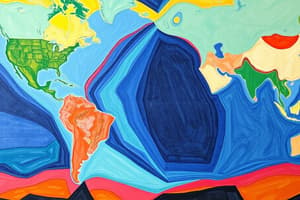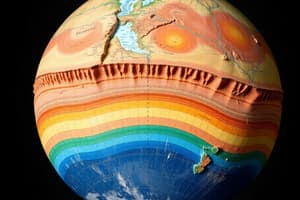Podcast
Questions and Answers
What is the theory that the surface of the earth is broken into larger pieces of crust called plates that ride along on a softer layer of the earth known as?
What is the theory that the surface of the earth is broken into larger pieces of crust called plates that ride along on a softer layer of the earth known as?
- Plate tectonics (correct)
- Continental drift
- Seafloor spreading
- Mantle convection
How thick can continental plates be?
How thick can continental plates be?
- Up to 200 km
- Up to 150 km (correct)
- Up to 50 km
- Up to 300 km
What is the upper part of the mantle called, on which the crustal plates ride?
What is the upper part of the mantle called, on which the crustal plates ride?
- Mesosphere
- Stratosphere
- Asthenosphere (correct)
- Lithosphere
What type of boundary occurs when two tectonic plates move away from each other?
What type of boundary occurs when two tectonic plates move away from each other?
Which theory proposed the idea of drifting continents before plate tectonics was established?
Which theory proposed the idea of drifting continents before plate tectonics was established?
What do geologists study?
What do geologists study?
What caused the mystery of drifting continents to be solved in the middle of the 20th century?
What caused the mystery of drifting continents to be solved in the middle of the 20th century?
What is the main theory of plate movement?
What is the main theory of plate movement?
What are the three main layers of the earth, as described in the text?
What are the three main layers of the earth, as described in the text?
What causes the rock in the mantle to move according to geologists?
What causes the rock in the mantle to move according to geologists?
What happens at converging boundaries?
What happens at converging boundaries?
What causes ridge push according to the text?
What causes ridge push according to the text?
What is thought to be the main source of heat driving plate movement?
What is thought to be the main source of heat driving plate movement?
How are convection currents in the mantle described in relation to a pot of boiling water?
How are convection currents in the mantle described in relation to a pot of boiling water?
What causes oceanic crust to be forced under another plate at converging boundaries?
What causes oceanic crust to be forced under another plate at converging boundaries?
Flashcards are hidden until you start studying
Study Notes
Plate Tectonics
- The theory describing the earth's surface as broken into tectonic plates that float on a semi-fluid layer is called plate tectonics.
- Continental plates can reach thicknesses of up to 100 kilometers.
Upper Mantle
- The upper part of the mantle, where crustal plates move, is referred to as the asthenosphere.
Plate Boundaries
- Divergent boundaries occur when two tectonic plates move apart, leading to the formation of new crust.
Continental Drift
- The theory of continental drift, proposed by Alfred Wegener, suggested that continents were once joined and have since moved apart.
Geology
- Geologists study the composition, structure, and processes of the Earth, including its materials and the forces shaping it.
Mystery Resolution
- The mystery of drifting continents was solved in the mid-20th century due to advancements in technology and the discovery of seafloor spreading.
Plate Movement Theory
- The principal theory explaining plate movement is based on convection currents in the mantle driven by heat from the Earth's core.
Earth's Structure
- The Earth consists of three main layers: the crust, the mantle, and the core.
Mantle Dynamics
- According to geologists, the movement of rock in the mantle is primarily caused by convection currents generated by heat varying within the mantle.
Convergence Effects
- At converging boundaries, tectonic plates collide, which can result in mountain formation, earthquakes, and volcanic activity.
Ridge Push
- Ridge push is caused by the weight of elevated mid-ocean ridges pushing lithospheric plates away from the ridge.
Heat Source
- The primary source of heat driving plate movement is the radioactive decay of elements within the Earth's core.
Convection Analogy
- Convection currents in the mantle are likened to a pot of boiling water, where hot material rises and cool material sinks, creating a cycle that facilitates plate movement.
Subduction Process
- At converging boundaries, oceanic crust is forced under another plate due to its higher density compared to continental crust.
Studying That Suits You
Use AI to generate personalized quizzes and flashcards to suit your learning preferences.




